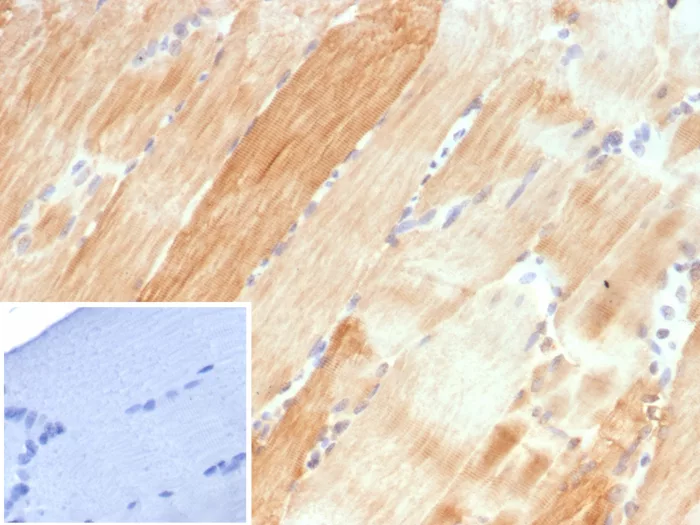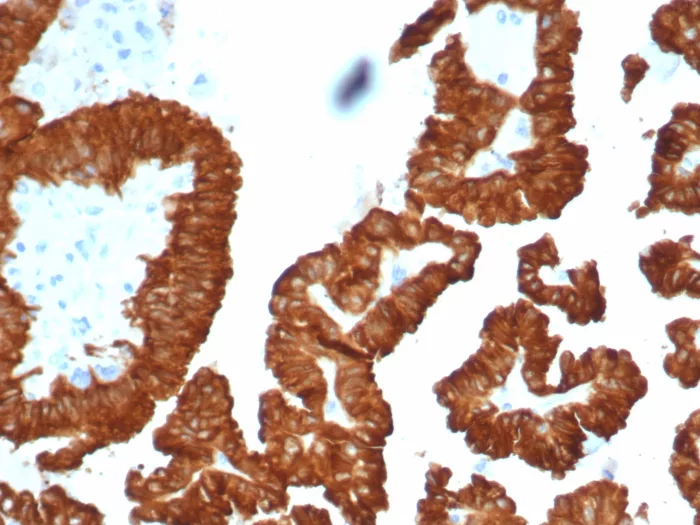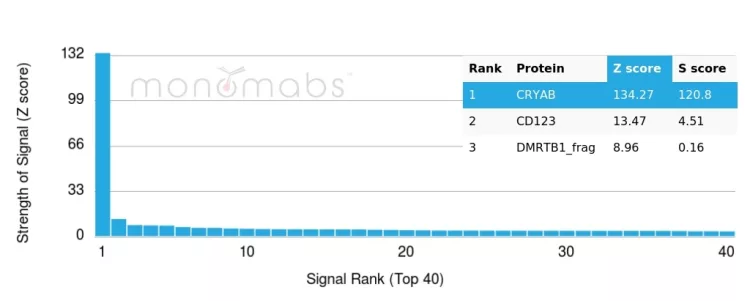Learn about our comprehensive antibody validation methods to ensure monospecificity. Antibody Validation>>

Formalin-fixed, paraffin-embedded human skeletal muscle stained with Crystallin Alpha B Mouse Monoclonal Antibody (CRYAB/4661). Inset: PBS instead of primary antibody; secondary only negative control.

Formalin-fixed, paraffin-embedded human kidney cancer stained with Crystallin Alpha B Mouse Monoclonal Antibody (CRYAB/4661). HIER: Tris/EDTA, pH9.0, 45min. 2°C: HRP-polymer, 30min. DAB, 5min.

Analysis of Protein Array containing more than 19,000 full-length human proteins using Crystallin Alpha B Mouse Monoclonal Antibody (CRYAB/4661). Z- and S- Score: The Z-score represents the strength of a signal that a monoclonal antibody (MAb) (in combination with a fluorescently-tagged anti-IgG secondary antibody) produces when binding to a particular protein on the HuProtTM array. Z-scores are described in units of standard deviations (SD's) above the mean value of all signals generated on that array. If targets on HuProtTM are arranged in descending order of the Z-score, the S-score is the difference (also in units of SD's) between the Z-score. S-score therefore represents the relative target specificity of a MAb to its intended target. A MAb is considered to specific to its intended target, if the MAb has an S-score of at least 2.5. For example, if a MAb binds to protein X with a Z-score of 43 and to protein Y with a Z-score of 14, then the S-score for the binding of that MAb to protein X is equal to 29.
Crystallins are the major proteins of the vertebrate eye lens, where they maintain the transparency and refractive index of the lens. Crystallins are divided into Î �, Î � and Î � families, and the Î �- and Î �-crystallins also compose a superfamily. Crystallins usually contain seven distinct protein regions, including four homologous motifs, a connecting peptide, and N- and C-terminal extensions. Î �-crystallins consist of three gene products, Î �A-, Î �B- and Î �C-crystallin, which are members of the small heat shock protein family (HSP 20). Î �-crystallins act as molecular chaperones by holding denatured proteins in large soluble aggregates. However, unlike other molecular chaperones, Î �-crystallins do not renature these proteins. Expression of Î �A-crystallin is restricted to the lens and defects of this gene cause the development of autosomal dominant congenital cataracts (ADCC). The human Î �B-crystallin gene product is expressed in many tissues, including lens, heart and skeletal muscle. Elevated expression of Î �B-crystallin is associated with many neurological diseases, and a missense mutation in this gene has co-segregated in a family with a Desmin-related myopathy.
There are no reviews yet.